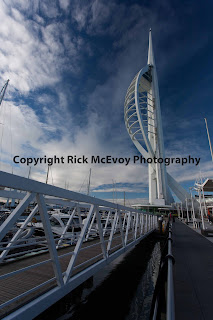The stunning Spinnaker Tower in Portsmouth, Hampshire, is 170 metres high, and overlooks Portsmouth Harbour and the Solent. It offers 23 miles of views on a clear day, and can also be seen from 23 miles away in favourable conditions!! The Tower is taller than London Eye and Big Ben.
You can get to the Spinnaker Tower on foot from Guwharf Quays which is a major retail with a variety of shops, discount outlets, restaurants and bars. There is a car park at the entrance to Gunwharf Quays.
The Spinnaker Tower really is a spectacular structure, and has three viewing decks. Deck 1 has a glass floor, Deck 2 has a cafe and Deck 3, The Crow’s Nest, is open to the elements.
The tower opened in October 2005, and was built as part of the Renaissance of Portsmouth Harbour Project. The tower is one of the most prominent landmarks in the City. This proposal for this Millennium Project was approved by the Millennium Commission in September 1995. Construction started however some time later, in November 2001. The tower opened to the public in October 2005.
I am going to concentrate in this blog on one photograph of the Spinnaker Tower, taken in November 2011, and the process of producing an HDR image.
Image 1 – Correct exposure.
This photograph was taken on my Canon Eos 5D using my 17-40mm F4 L lens, with an exposure of 1/100th of a second at f16, ISO400.
This image has not been edited, and was taken using the correct exposure suggested by the camera, using aperture priority mode.
In this image I am trying to capture the entire structure and convey the overall size, scale and grandness of the tower. I like the composition and the way that the eye is drawn into the photograph and the tower itself by the jetty on the left. The sky is interesting, and adds to the drama of the image. The same view with a clear blue sky would have not had anywhere near the impact that this image has. Unsettled weather often produces great and unusual skies which can add great drama to images.
Image 2 – 1 stop underexposed
This is the second image of the Spinnaker Tower. The first image was taken on my Canon Eos 5D using my 17-40mm F4 L lens with an exposure of 1/100th of a second at f16, ISO 400. This image was taken using an exposure of 1/200th of a second, f16, ISO 400. By increasing the shutter speed by one stop I have reduced the amount of light the sensor receives by one stop, achieving an underexposed image.
Image 3 – 1 stop over exposed

Image 3 – 1 stop over exposed

This is the third image of the Spinnaker Tower. The first image was taken on my Canon Eos 5D using my 17-40mm F4 L lens with an exposure of 1/100th of a second at f16, ISO 400, the second image was taken using an exposure of 1/200th of a second, f16, ISO 400. This image was taken with the same settings but a shutter speed 1/50th of a second. By reducing the shutter speed by one stop from the correct exposure I have doubled the amount of light reaching the sensor, resulting in an over exposed image, capturing the detail in the shadows lost on the other two exposures.
I use auto-bracketing on my camera to produce a set of three images, the first one the correct exposure, the second photograph one stop under-exposed and the third shot one stop over exposed. The reason for this is that quite often it is not possible to capture the whole tonal range in a scene.
I use auto-bracketing on my camera to produce a set of three images, the first one the correct exposure, the second photograph one stop under-exposed and the third shot one stop over exposed. The reason for this is that quite often it is not possible to capture the whole tonal range in a scene.
HDR images will be posted separately.






